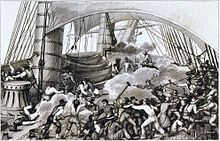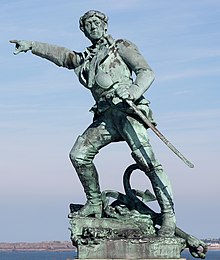Robert Surcouf
Robert Surcouf (born December 12, 1773 in Saint-Malo , France, † July 8, 1827 in Saint-Malo) was a French pirate against Great Britain during the Revolutionary Wars ; During the continental blockade, he also operated other privateers as an entrepreneur .
Robert Surcouf inflicted considerable losses on British trade during his pirate voyages in a total of 50 months at sea, 47 enemy ships were captured or sunk. His commandos were La Creole , La Clarisse , La Confiance and Charles (ex Le Revenant ). He was made a baron by Napoleon in 1810 .
Life
Robert Surcouf, whose ancestors included several French corsairs , first attended a Jesuit school, often incorrectly referred to as a seminary . But in 1786 he left school and decided to go to sea. Allegedly he enlisted in the Navy in 1788 and made his first sea voyage to India in 1789, during which he received military and nautical training, but there is no source evidence for this. That is why he could not be made lieutenant for alleged exceptional achievements in a shipwreck in 1791 . Since he was penniless, he hired the Corvette Bienvenue for the trip home . This was his only voyage on a warship that can be proven by sources.
In January 1792 he returned to revolutionary France as a mate on the warship and immediately left the navy. In August 1792 he was hired on a merchant ship and went to the French colony Île-de-France (Mauritius) . Once there, he learned of the war against Great Britain , which made merchant shipping impossible. The governor appointed him "Enseigne de Vaisseau" in the local defense fleet. The legend made it a regular officer's license as a lieutenant. When the Île-de-France was threatened by a British squadron, according to legend, Surcouf went to the French frigate Cybèle as second officer .

The small French squadron, inferior to the British in terms of firepower, consisting of two frigates and an armed merchant ship , succeeded in pushing back the British and thus securing the French possession of Île-de-France, with Surcouf supposedly continuing to prove itself. But Surcouf was probably not on board at all. Then he accepted the offer from two shipowners in Île-de-France and converted the small merchant ship Emilie into an armed pirate with four cannons and a crew of 30. With this ship he managed to capture four British ships, including the Triton of the British East India Company with 26 cannons and a crew of 150 as well as two ships loaded with rice and corn. By bringing in these prizes , Surcouf was able to alleviate the famine in Île-de-France.
In the capital Port Louis , Surcouf was celebrated as a hero after his return in March 1796. Because of differences of opinion with the governor of the colony - Surcouf did not have a letter of invasion - he first had to return to France to assert his rights. From a legal point of view, the capture without a letter of war was piracy. However, his reputation had already preceded him, and he received his booty and a subsequent letter of piracy before the Council of Five Hundred .
In 1798 he again armed a merchant ship. With the Clarisse (18 cannons and 105 men crew) he set out again for the Indian Ocean in August. In December of the same year he reached the Île-de-France. On the way there he had already captured two British and two Portuguese ships. From Port Louis he drove on to Sumatra , where he was able to capture two more British ships in a daring action.
On November 11, 1799, he captured the British three- master Auspicious (20 cannons), the charge of which was worth more than a million francs . In the Bay of Bengal , Surcouf only escaped capture by the British because he had eight cannons of his ship thrown overboard to make it lighter and therefore faster. During the return to Île-de-France he was able to capture a British and an American ship. Since his own ship urgently had to go to the shipyard, he was given the command of another 18-gun ship, with which he set off for a pirate voyage in the Indian Ocean in March 1800.
On October 7, 1800 Surcouf succeeded in capturing the British East India Company, Kent, who was armed with 26 cannons . There are myths surrounding this victory. Many French sources speak of the Kent warship with a crew of up to 400 men and 40 cannons; in fact, the Kent was an armed merchant ship with a crew that was barely sufficient in number or experience to effectively operate the 26 cannons. After this success, Surcouf returned in triumph to Île-de-France. Then he went back to France, chased by the British, who had offered him a head premium of five million francs. On April 13, 1801, he arrived in La Rochelle .
By participating in the booty, Surcouf had achieved considerable wealth. He settled in St. Malo, became a successful businessman, and got married. Surcouf turned down an offer from the First Consul Napoleon Bonaparte in 1803 to promote him to captain and send him to the Indian Ocean with orders for two frigates , as Napoléon did not want to give him the freedom of action he wanted. However, before Napoléon he pleaded for an armament of the fleet, in which Surcouf saw an effective weapon in the fight against Great Britain. For his services, Surcouf received membership in the Legion of Honor on July 18, 1804 .
From 1804 the now very wealthy Surcouf became the owner of 14 ships in St. Malo. However, he was not very successful as a ship owner. Four of his ships were lost to capture and five trade voyages ended in loss. In 1807 Surcouf decided to return to the Navy. He had the three-masted ship Revenant (20 cannons ), which was quite fast at twelve knots (22 km / h), built according to his specifications with a hull covered with copper sheet and began his voyage to the Indian Ocean on March 2, 1807.
On the way to Île-de-France, he has already been captured several times. He broke the British blockade of the Île-de-France and found the colony in total poverty. Surcouf went on a pirate voyage, which was not crowned with success, as the British ships immediately fled when they recognized Surcouf's ship. Unsuccessfully, he returned to Île-de-France on January 31, 1808 and decided to end his military career. His cousin Joseph Potier continued the operations successfully.
When the commander of the French troops on the Île-de-France, Comte Decaen (1769-1852), Surcouf's ship Revenant was confiscated for the defense of the island, violent arguments broke out between the men. Since Decaen could not maintain and repair the ship, Surcouf eventually bought the ship back, renamed it Charles , and returned to France. The dispute with Decaen and his departure from the Île-de-France threatened by the enemy led to the confiscation of Surcouf's goods in the Indian Ocean by the governor of Île-de-France.
On February 4, 1809, Surcouf reached France again with the Charles and a cargo worth eight million francs. He went to Paris immediately because of the dispute with Decaen . Because of the laudatory report by Minister Desrès, Surcouf was congratulated on his successes by Emperor Napoléon and raised to the rank of count . In 1810, Napoléon also canceled the confiscation of Surcouf's goods. After his return, Surcouf settled permanently in St. Malo. Because of his merits, he received an annuity.
In 1812 Surcouf got a new ship with the Le Renard . It was under the command of Captain Emmanuel-Yves Leroux-Desrochettes . On September 9, 1812, the 70-ton cutter with its ten carronades , four cannons and a 46-man crew encountered the stronger British Alphea (16 cannons, 80-man crew). At 3 a.m., they hit their powder room . There was an explosion that none of the crew survived. The Le Renard returned to her home port with 13 undamaged men, but heavily damaged herself. In January 1814, Surcouf was appointed colonel in the National Guard in St. Malo.
Although he was always connected to Napoléon, he did not join the emperor after his return during the 100-day rule . Napoléon's fate ultimately also meant the end of the pirate era. After Surcouf's death, his body was escorted to the cemetery in a parade of 50 boats and ships.
After Surcouf's death

After Robert Surcouf, ships were repeatedly named after him in the French Navy (see Surcouf (ship name) ).
His life was filmed in the feature films Under the Flag of the Tiger ( Surcouf, le tigre des sept mers , 1966) and Thunder over the Indian Ocean ( Il Grande colpo di Surcouf , 1966) with Gérard Barray in the lead role. Karl May made him the hero of his novella Robert Surcouf - Ein Seemannsbild or Der Kaperkapitän in Halbblut , Works Vol. 38, 1896/97 in 1882 .
There is a monument to Surcouf in Saint-Malo. The city is also the home port of Le Renard , the replica of his ship.
Quotes
Napoléon, who was not very lucky with his maritime plans, once offered Surcouf a command in the Navy. But this refused him. Napoléon: “I'll make you a rich man.” Surcouf: “I've already paved the floor of my cabinet with your gold coins.” Napoléon snubbed: “How? But then you keep stepping on my head. "Surcouf:" No, you are on the edge. "
After the capture of the Kent in the Bay of Bengal in 1800 the following dialogue ensued between a British officer and Surcouf: British officer: “You French fight for the money, we English for the sake of honor.” Surcouf: “Everyone fights for what he does not has. "
There is also the following anecdote about Robert Surcouf: After Napoleon's defeat at Waterloo, he witnessed how some officers of the allies expressed disparagingly about the overthrown emperor. Thereupon he challenged them all one after another to a duel, in which he proved to be superior to them. When the last officer, a young ensign, stepped forward, Surcouf simply said, “I don't fight with children. Run home and tell your people: This is how a Napoleonic soldier beats himself. ”There is no English source to support this anecdote.
literature
- Lutz Bunk: 50 classic ships. Collection Gerstenberg visual. ISBN 978-3-8067-2548-3 , pp. 154-157.
- Charles Cunat: Histoire de Robert Surcouf, Capitaine de corsaire. Collection L'Amateur Averti; Éditions La Découvrance (Réédition de l'édition de 1855). ISBN 2-910452-02-6 (French).
Web links
- German site about Surcouf
- Film entry for "Under the flag of the tiger"
- Film entry for "Thunder over the Indian Ocean"
- Karl May's semi-historical novella
Individual evidence
- ↑ Les amis du patrimoine Napoléonien, French biography
- ↑ a b Chacun se bat pour ce qui lui manque on pirates-corsaires.com
- ↑ Wolfram zu Mondfeld: Fate of famous sailing ships.
| personal data | |
|---|---|
| SURNAME | Surcouf, Robert |
| BRIEF DESCRIPTION | French naval officer and corsair |
| DATE OF BIRTH | December 12, 1773 |
| PLACE OF BIRTH | Saint Malo , France |
| DATE OF DEATH | July 8, 1827 |
| Place of death | Saint Malo , France |

